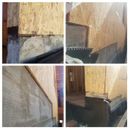Affordable airtightness
Hello,
I am looking for some suggestions on how best to achieve an air tight enclosure. Given that our scope includes sheathing the entire exterior of the structure, my plan was to have the OSB sheathing act as THE continuous air barrier. I have learned a lot at GBA, but could use some additional clarity on the following two questions:
1) Other than tape, what is an affordable and effective product for sealing the joints between OSB sheathing? Tape is great but very pricey.
2) What is the best product, or combination of products, to air seal the space between the OSB sheathing and the concrete foundation wall? I realize a gasket would have been preferable, but unfortunately that window of opportunity has passed. The only thing separating the mud sill from the concrete foundation wall is a piece of Grace Vycor with the backing still in place.
Thanks in advance for your help!
GBA Detail Library
A collection of one thousand construction details organized by climate and house part










Replies
Gregory,
If your OSB is already installed, the best method of air sealing is to tape the seams. Here is a link to an article on tapes: Return to the Backyard Tape Test.
If you hadn't installed your OSB yet, you might have considered the use of caulk between the sheets of OSB and the framing. But your OSB has already been installed.
Although I don't think you will save any money compared to tape, another approach worth considering is the use of sprayable caulk (Owens Corning EnergyComplete or Knauf EcoSeal) on the interior side. Here is a link to an article on the topic: Air Sealing With Sprayable Caulk.
To seal the crack between your mudsill and your concrete foundation, the best product is a high-quality tape like Siga Wigluv. The second-best approach is to caulk the crack on the interior with a high-quality caulk like silicone or polyurethane caulk.
Note to GBA readers: The time to develop an air sealing plan is before construction begins -- not after your walls are already framed and sheathed.
Thanks for the thoughtful response Martin. You are absolutely right - the time to develop an air sealing plan is before construction begins! With that said, it is humbling how quickly "nice to haves" like air sealing falls to the wayside when your builder is not 100% on board and the homeowner is juggling the responsibilities of a day job and a family! I went ahead and purchased 3M All Weather Tape 8067, polyurethane caulk, and backer rod. Thanks for the helpful suggestions!
On additional question on my mind is that the front facade of our house, our framer will be installing the shear wall on the inside of the framing because of a large porch that is attached to house. The inside shear wall of the front facade will be interrupted by floor and ceiling joists and interior walls. This will make it difficult to maintain a continuous air barrier. Unfortunately, disconnecting the porch is not going to be an option for us. What are the best techniques for air sealing the front facade of the home? Does anyone have air sealing details for this kind of scenario?
Gregory,
I'm not sure that I understand your question. But the easiest way to proceed would be to open up part of the ceiling near the rim joist area, and to spray the rim joist area with closed-cell spray foam, connecting the air barrier on the first floor with the air barrier on the second floor.